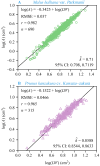Testing the Validity of the Montgomery-Koyama-Smith Equation for Calculating the Total Petal Area per Flower Using Two Rosaceae Species
- PMID: 39771198
- PMCID: PMC11677890
- DOI: 10.3390/plants13243499
Testing the Validity of the Montgomery-Koyama-Smith Equation for Calculating the Total Petal Area per Flower Using Two Rosaceae Species
Abstract
The size of floral organs is closely related to the successful reproduction of plants, and corolla size is, to some extent, indicative of the size of floral organs. Petals are considered to be homologous to leaves, so we also attempted to estimate the area of a single petal using the method that is typically employed for estimating single leaf area (i.e., the Montgomery equation). Additionally, we estimated the total petal area per flower (AT; i.e., the whole corolla area) using the method designed for estimating the total leaf area per shoot (i.e., the Montgomery-Koyama-Smith equation). The Montgomery equation (ME) estimates the leaf area by assuming that the leaf area is proportional to the product of leaf length and width. The Montgomery-Koyama-Smith equation (MKSE) assumes that the total leaf area per shoot is proportional to the product of the sum of individual leaf widths and the maximum individual leaf length. To test the validity of the ME for predicting petal area, a total of 1005 petals from 123 flowers of two Rosaceae species, which exhibit a certain variation in petal shape, were used to fit the relationship between the petal area (A) and the product of petal length (L) and width (W). Two equations, including the MKSE and a power-law equation (PLE), were used to describe the relationship between the total petal area per flower and the product of the sum of individual petal widths and the maximum individual petal length. The root-mean-square error (RMSE) and the Akaike information criterion (AIC) were used to measure the goodness of fit and the trade-off between the goodness of fit and model's structural complexity for each equation. The results show that the ME has a low RMSE value and a high correlation coefficient when fitting the relationship between A and LW for either of the two species. Additionally, the MKSE and the PLE exhibit low RMSEs and AICs for estimating the AT of both Rosaceae species. These results indicate that the ME, MKSE, and PLE are effective in predicting individual petal area and total corolla area, respectively.
Keywords: Montgomery equation; Montgomery–Koyama–Smith equation; Rosaceae; individual petal area; total petal area per flower.
Conflict of interest statement
The authors declare no conflicts of interest.
Figures







Similar articles
-
The Geometric Series Hypothesis of Leaf Area Distribution and Its Link to the Calculation of the Total Leaf Area per Shoot of Sasaella kongosanensis 'Aureostriatus'.Plants (Basel). 2024 Dec 29;14(1):73. doi: 10.3390/plants14010073. Plants (Basel). 2024. PMID: 39795333 Free PMC article.
-
Variation of leaf shape with tree size: a case study using Camptotheca acuminata Decne.Front Plant Sci. 2024 Nov 20;15:1468483. doi: 10.3389/fpls.2024.1468483. eCollection 2024. Front Plant Sci. 2024. PMID: 39634068 Free PMC article.
-
Nondestructive estimation of leaf area for 15 species of vines with different leaf shapes.Am J Bot. 2020 Nov;107(11):1481-1490. doi: 10.1002/ajb2.1560. Epub 2020 Nov 9. Am J Bot. 2020. PMID: 33169366
-
Tree Size Influences Leaf Shape but Does Not Affect the Proportional Relationship Between Leaf Area and the Product of Length and Width.Front Plant Sci. 2022 Jun 9;13:850203. doi: 10.3389/fpls.2022.850203. eCollection 2022. Front Plant Sci. 2022. PMID: 35755713 Free PMC article.
-
Bridging the gaps: evolution and development of perianth fusion.New Phytol. 2015 Oct;208(2):330-5. doi: 10.1111/nph.13517. Epub 2015 Jun 11. New Phytol. 2015. PMID: 26094556 Review.
Cited by
-
Application of the Montgomery Equation in Morphometric Analysis of Tepals: A Case Study of Liriodendron × sinoamericanum.Plants (Basel). 2025 Jun 17;14(12):1861. doi: 10.3390/plants14121861. Plants (Basel). 2025. PMID: 40573848 Free PMC article.
References
-
- Goethe J.W. Versuch die Metamorphose der Pflanzen zu Erklären. Ettinger; Gotha, Germany: 1790.
Grants and funding
LinkOut - more resources
Full Text Sources

